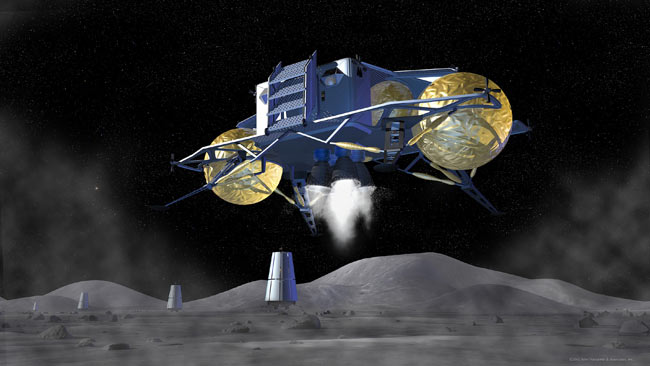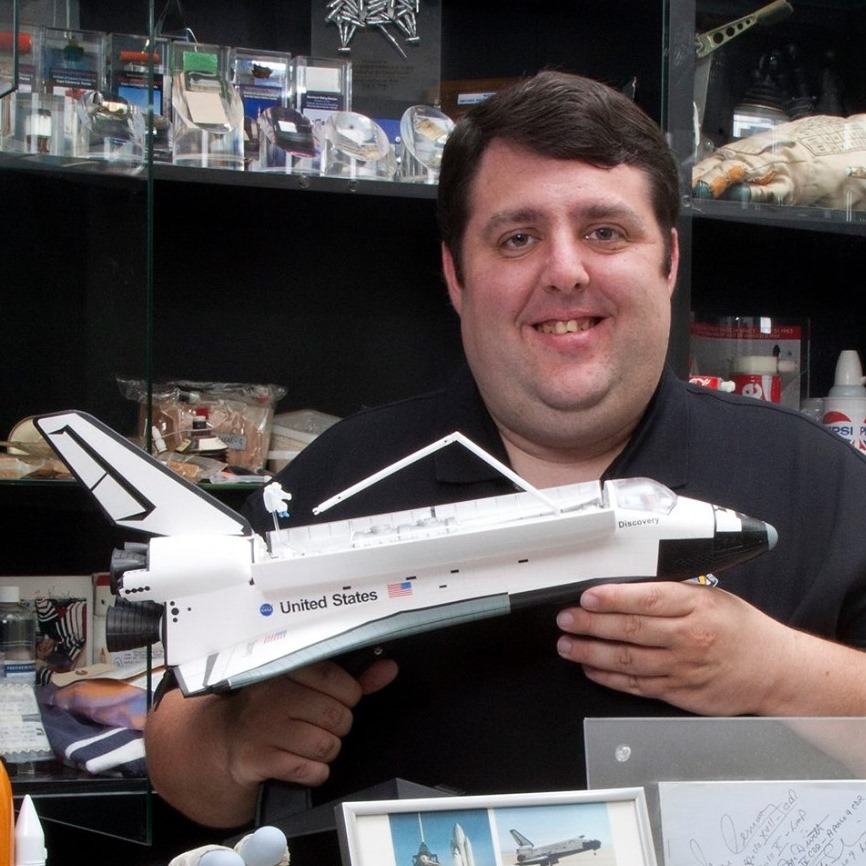NASA Names Next Generation Moon Lander 'Altair'

Move over Eagle, the Altair has landed.
NASA today introduced a new name and logo for its nextgeneration lunar lander, which was previously referred to as the Lunar SurfaceAccess Module, or LSAM for short.
"That's the name they chose," said Jeff Hanley,NASA's Constellation Program manager, under which Altair falls. "We canstop calling it LSAM or esoteric things like that."
Hanley revealed the new name at a meeting with industryrepresentatives held at Johnson Space Center to provide a general background tothe lunar lander preceding NASA soliciting ideas for its development fromcontractors.
Sparked by a star, motivated by a mission
"Altair is the brightest star in the constellation Aquilaand is the twelfth brightest star in the night sky," wrote Lauri Hansen,NASA's Altair project manager, in an e-mail sent to Hanley this morning, a copyof which was obtained by collectSPACE.com. "The word 'Altair'finds its origins in Arabic and is derived from a phrase that means 'the flyingone'," she continued.
"In Latin, 'Aquila' means Eagle, tying our new landerto the historic Apollo 11 Eagle," concluded Hansen, referring to the vehiclethat brought mankind's first two men to the lunar surface in July 1969.
Breaking space news, the latest updates on rocket launches, skywatching events and more!
The Altair project logo emphasizes thatconnection, using the major design element from the Apollo 11 patch as its own.Both emblems depict a bald eagle clasping an olive branch in its talons, animage chosen by Michael Collins, Apollo 11's command module pilot, based on aphoto in a 1965 book published by National Geographic.
"We needed something simpler, yet something whichunmistakably said peaceful lunar landing by the United States," Collinswrote in his 1974 book, "Carrying the Fire". "Jim Lovell, Neil[Armstrong's] backup, introduced an American eagle into the conversation. Ofcourse! What better symbol -- eagles landed, didn't they? At home I skimmedthrough my library and finally found what I wanted in a National Geographicbook on birds: a bald eagle, landing gear extended, wings partially folded,coming in for a landing. I traced it on a piece of tissue paper and sketched inan oblique view of a pockmarked lunar surface," wrote Collins.
The Altair version of Collins' eagle greatly simplifies thedetail of the Apollo artwork and reverses the direction that the bird islanding on the lunar surface.
The newer logo also spells out the name "Altair"in a font that is reminiscent of how "Apollo" appears on its projectemblem.
Part of the family
The Altair logo is triangular in shape, continuing a themethat is present in the emblems for its parent program and sibling projects.
Under NASA's Constellation program, Orion crew vehicles andAltair lunar landers will launch to Earth orbit on Ares I and Ares V rocketsrespectively. Like the patches for the other initiatives, the Altair insigniaincludes 10 stars in its background, a symbol previously attributed to each ofthe 10 NASA nationwide centers working to return astronauts to the Moon.
As currently envisioned by NASA, Altair landers will bringfour astronauts at a time to the lunar surface, as well as supplies andequipment to establish an outpost. An initial return to the Moon is targeted tolaunch before year 2020.
The Constellation program rose as a result of the Vision forSpace Exploration proposed by President George W. Bush in January 2004, afterthe loss of shuttle Columbia eleven months earlier.
In June 2006, NASA revealed the name and logo for its newlaunch vehicles, Ares I and V. Less than a month later,collectSPACE.com was the first to report the title and emblemgiven to the crew exploration vehicle Orion, as was confirmed by NASA in August 2006.
NASA previously applied "Altair" as aninternal-use only "notional" title for the Orion crew vehicle. Theagency has also used the name for a high-altitude unmanned aerial vehicle(UAV).
All four insignias, including the Constellation and Altairlogos, were designed for NASA by Michael Okuda, who may be best known for hiswork on the Star Trek series.
Click here to see the Altair project logo atcollectSPACE.com.
- VIDEO: Moon 2.0: Join the Revolution
- VIDEO: A New Era of Exploration with NASA's Orion and Ares
- IMAGES: NASA's Next Spaceship
Copyright 2007 collectSPACE.com. All rights reserved.
Join our Space Forums to keep talking space on the latest missions, night sky and more! And if you have a news tip, correction or comment, let us know at: community@space.com.

Robert Pearlman is a space historian, journalist and the founder and editor of collectSPACE.com, a daily news publication and community devoted to space history with a particular focus on how and where space exploration intersects with pop culture. Pearlman is also a contributing writer for Space.com and co-author of "Space Stations: The Art, Science, and Reality of Working in Space” published by Smithsonian Books in 2018.
In 2009, he was inducted into the U.S. Space Camp Hall of Fame in Huntsville, Alabama. In 2021, he was honored by the American Astronautical Society with the Ordway Award for Sustained Excellence in Spaceflight History. In 2023, the National Space Club Florida Committee recognized Pearlman with the Kolcum News and Communications Award for excellence in telling the space story along the Space Coast and throughout the world.
